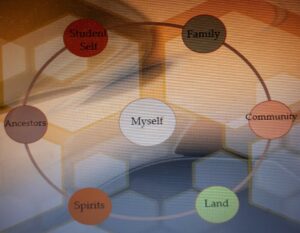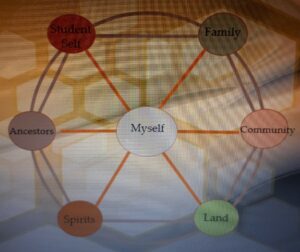EDUC 441: Innovative Community Based Approaches
The learning for this course was culminated through an inquiry project. You can see the full PowerPoint by following this link: Inquiry Project for 441 PowerPoint
I have to admit that I was not happy or inspired when we received this assignment. I was actually angry and did not want to do an Inquiry at all, about anything, ever. Since I was in a place of mental and emotional overwhelm, where I felt like if I focused on one thing everything else was going to fall apart, and because understanding the First People’s Principles of Learning is something I’ve made an effort to focus on throughout my Teacher Candidate journey, I chose the following Inquiry Question:
How do I support my own well-being while simultaneously supporting the well-being of the student self, the family, the community, the land, the spirits, and the ancestors?
I had narrowed it down to just 6 things to worry about, and myself, and I still wasn’t sure how to go about this. When I asked other educators, they said things like “You just do what you can” (Heenan 2021), and “Focus on one aspect and do it well” (Desbiens 2021). These things sound good, but what do they actually mean? How do I do it? Then I remembered one of the first things Dr. Fraser had explained to us about First Peoples’ world views: “All things are connected” (Fraser 2020).
and do it well” (Desbiens 2021). These things sound good, but what do they actually mean? How do I do it? Then I remembered one of the first things Dr. Fraser had explained to us about First Peoples’ world views: “All things are connected” (Fraser 2020).
I started to think about the connections that might exist between the elements themselves and between them and myself. Within the circle,  there are other geometric shapes (hexagon and triangles). For me, these symbolize all the other things that I care about, like many of the things that I was juggling at the beginning of this story. There is a finite amount of space here – only a certain amount of cares that I can give, so I need to choose carefully what I allow back into my care-spaces. The periphery of the circle, inside the edges of the hexagon, is all that other stuff goes – the things I don’t care about that are still a part of my life. I don’t have to like it and don’t have to let them in, but they remain, ready to implode my life again if I don’t take care of myself.
there are other geometric shapes (hexagon and triangles). For me, these symbolize all the other things that I care about, like many of the things that I was juggling at the beginning of this story. There is a finite amount of space here – only a certain amount of cares that I can give, so I need to choose carefully what I allow back into my care-spaces. The periphery of the circle, inside the edges of the hexagon, is all that other stuff goes – the things I don’t care about that are still a part of my life. I don’t have to like it and don’t have to let them in, but they remain, ready to implode my life again if I don’t take care of myself.
The interesting thing about hexagons is that multi-dimensional geometric shapes with only hexagonal faces of the same size can not exist. There will always be pentagons in these types of shapes, so a model with only hexagons has to be flat, or net-like. 
In case you are like me and the kind of person who needs a Mathematical Proof:
Once I came to this realization, then I started to think about more connections, and it started to make sense; all at once, I could see that people are connected to each other through the aspects of self, family, community, land, spirits and ancestors. The First People’s Principle behaves as a framework, or net, that holds people within it. I don’t have to hold it up, because it holds me. I can be assured that everything will not fall apart if I take the time to focus, learn about, or maintain one part. However, like a net, if I don’t maintain the aspects, the connections will deteriorate and I could fall or let others down. That doesn’t mean that I have to do it all at once, or all by myself, though.
framework, or net, that holds people within it. I don’t have to hold it up, because it holds me. I can be assured that everything will not fall apart if I take the time to focus, learn about, or maintain one part. However, like a net, if I don’t maintain the aspects, the connections will deteriorate and I could fall or let others down. That doesn’t mean that I have to do it all at once, or all by myself, though.
Instead, because we are all connected through the aspects of the network and our connections to one another, as long as some people are working on some aspect of supporting the well-being of self, family, community, land sprits, and ancestors all the time, they will continue to hold. To be a healthy person, it would be preferable to maintain balance, but if an individual needs to focus on one aspect for a little while, that is OK, as long as everyone focuses on something. In the context of Inquiry, a continuous return to scanning is necessary.
The Answer to my Inquiry Question
How do I support my own well-being while simultaneously supporting the well-being of the student self, the family, the community, the land, the spirits, and the ancestors?
The answer is threefold:
- Don’t. Have faith and allow the interconnected network to support me when I need to focus on myself. Additionally, when I model focusing on myself when I need to, it also shows students that it is alright to focus on themselves when they need to. In this way, a teacher can support themselves while simultaneously supporting the self of the student – So this one aspect worked out!
- However, I also need to do my part to support the aspects of the network when I have the ability. I can focus on one thing at a time but it is important to maintain balance.
- More Questions, such as: What, exactly will I do to support the well-being of the self, the family, the community, the land, the spirits, and the ancestors? How will I support them individually, or as a collective? When, How much?
My conclusions
Firstly, I could still work on my model. I don’t like that it looks fixed. I would like to try something with wire and beads, to see if I could build a 3-D, tangible piece that represents my thinking better and allows for movement, or maybe an animated, computer model if I ever got really ambitious. Secondly, relief. I don’t have to do it all, and I’m not slacking if I don’t do it all! Next, it’s ok to slow down and focus on one thing; do it well and so that I can finish and I don’t have to juggle it anymore. Also, whether maintaining myself through self-care or other means, or maintaining your relationships with the people and other aspects that I care about, maintenance needs to be done to keep things from falling apart. As well, only make space for the things you care about, and push the rest into the periphery.
Finally, inquiry might not be completely and utterly evil. After all, it helped dig me out of the pit of despair that I was in I started this block. I think the villain might have actually been my own unwillingness to change what I had done for so long, that wasn’t working anymore. So, as a villain somewhat – at least partially – redeemed, I have to admit that the learning from this inquiry project helped me to regain and then maintain the focus I needed to get through each assignment of this Block, one at a time, even when it felt like I was never going to be done. I’m still not its biggest fan, but overall, begrudgingly, I have to give some credit to Inquiry.
References:
CoryGCoryG 76911 gold badge66 silver badges1616 bronze badges, Brian TungBrian Tung 30.3k33 gold badges3131 silver badges6262 bronze badges, NarasimhamNarasimham 34.4k77 gold badges3232 silver badges7878 bronze badges, & vadim123vadim123 80.5k99 gold badges110110 silver badges212212 bronze badges. (1965, July 1). Is it possible to have a spherical object with only hexagonal faces? Mathematics Stack Exchange. https://math.stackexchange.com/questions/2121175/is-it-possible-to-have-a-spherical-object-with-only-hexagonal-faces
First Nations Education Steering Committee (2008). First Peoples Principles of Learning. Teacher resource poster: English First Peoples. http://www.fnesc.ca/first-peoples-principles-of-learning/.
Fraser, T. (2020, September). Setting the Context. Education 346: Introduction to Aboriginal and Indigenous Education. Online.
Kaser, L., & Halbert, J. (2017). The Spiral Playbook: Leading with an inquiring mindset in school systems and schools. Canadians for 21st Century Learning and Innovation. C21 Canada. http://c21canada.org/wp-content/uploads/2016/10/Spiral-Playbook.pdf.
Simpson, J., & Desbiens, A. (2021, July 9). Interview With Teacher 2: Supporting the Well-Being of Self as Pertaining to First Peoples Principles of Learning. personal.
Simpson, J., & Heenan, A. (2021, July 10). Interview With Teacher 1: Supporting the Well-Being of Self as Pertaining to First Peoples Principles of Learning. personal.
Leave a Reply